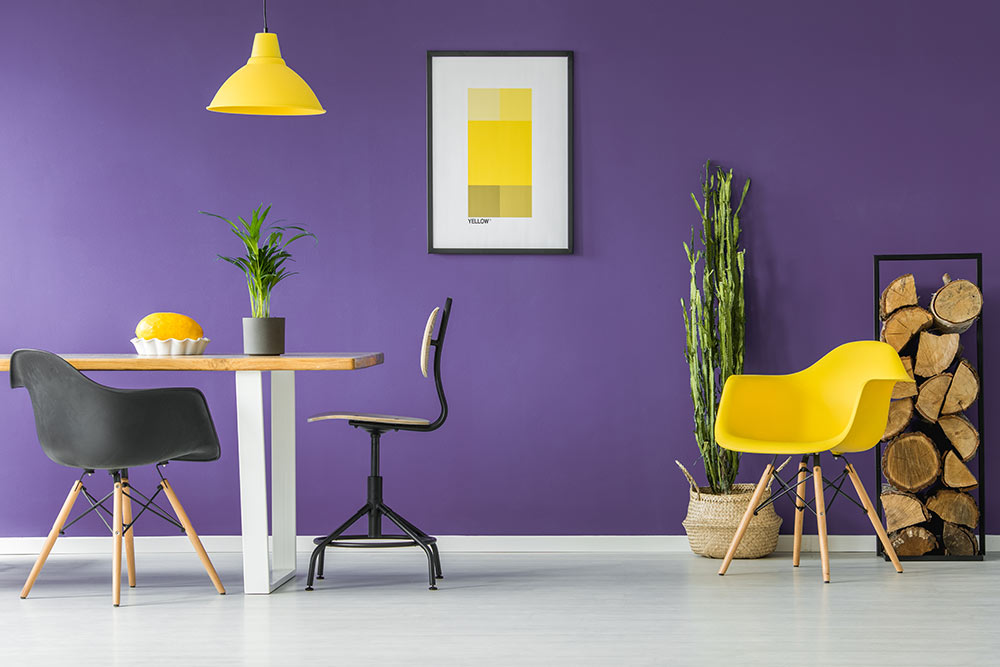What’s the secret behind choosing the right paint colour scheme for your home? While there are a few guidelines and principles, the real secret is to trust your personal preference when you choose the paint colours for your home interior. Go with the colours you can live with and will come home to.
Here, we will discuss a tips to help you choose the right paint colours for your home interior.
- Understand the Paint Colour Psychology in Interior Design
- Create a Unified Colour Scheme
- Make a Colour Palette from Your Existing Decor
- Choose the Paint Colour According to the Room Type
- Consider the Impact of Natural or Artificial Lighting on the Paint Colour
- Choose a Paint Colour to Make Your Rooms Look Spacious
- Do Not Forget the Power of Whites
- Common Mistakes To Avoid When Choosing the Best Paint Colour for Your Home
- FAQs
Choosing the Right Paint Colour for Your Home
Paint colours can be tricky, but with the right guidelines and effort, you can choose just the right colours. This way, you can experience the satisfaction of a well-painted home! The right paint colours can transform a space while creating a welcoming atmosphere. They can also enhance your house’s architectural features, define open-floor plans, and set the mood of your home.
Here’s a step-by-step guide on how to choose the best paint colours for your home interior, making every corner look refreshed and coordinated.
Understand the Paint Colour Psychology in Interior Design
Colour is a crucial part of interior design, deeply impacting our behaviours and emotions. By understanding colour psychology and the effects of different colours, you can create spaces with different moods and enhanced functions.

The Emotional Impact of Colours
Different colours have different emotional impacts. For example, warm hues like red, yellow and orange have an energising and stimulating effect, while cool tones like blue, purple and green are restful and calm.
Hence, it is recommended to:
- Use warm paint colours in social rooms like the living, dining room and kitchen.
- Cooler tones in private spaces such as bedrooms and work-from-home spaces.
- Remember your personal preference as well. What feels inviting and stimulating to others might not feel the same to you.
Create a Unified Colour Scheme
A well-planned theme can make your home feel harmonious and thoughtfully designed. You can create a cohesive colour scheme from room to room just by following a few basic principles, such as:
The 60-30-10 Rule
The 60-30-10 rule is a basic interior design principle for creating appealing and visually balanced spaces. According to this rule, 60% of the space should be a dominant colour, 30% should be a secondary colour and 10% an accent hue.
This distribution typically refers to the walls as the dominant colour. The furniture and upholstery are the secondary colour while the decor and artwork refer to the accent colour.
By following this rule, your space won’t feel overpowered by colours and it gives an inviting appearance.
Make a Colour Palette from Your Existing Decor
Professionals recommend that choosing the right colour scheme for your home starts with matching it with the existing objects.
For example, take your favourite object from home to the paint store. It can be a pillow, a room decor item, a rug or anything else. Find at least three sample strips for those colours and you will instantly have 15-18 different hues to choose from.
If you cannot decide on the best colour, look at the dark colour at the bottom of the shade card. If you like it, you can choose the middle shade.
The moral of the tip: Start your selection from the darkest hues. If you start from the top (the lightest ones), all shades will appear the same.

Choose the Paint Colour According to the Room Type
Each room in your house serves a different function. Hence, the colour scheme for each must be different to reflect and enhance its purpose. For example:
Paint Colour for Bedroom
Your bedroom is your personal and private space. Cool and calming tones like lavender, pale blues and turquoise greens are ideal for inducing restfulness and sleep.
However, if you like warmer hues, be sure to pick their muted versions. Try pale yellows or terracotta, to avoid feeling overwhelmed.
Paint Colours for the Dining Hall and Kitchen
Kitchens and dining rooms are places to stimulate hunger and conversation. Warm shades like reds, oranges and yellows can be effective in such spaces.
However, too bright shades can make the space look overwhelming. Hence, you can pair them with neutral backdrops like muted greens and blues to create a serene mood.
Paint Colours for Living Rooms
Living rooms are the heart of every home. They are where friends and families get together. Hence, welcoming tones like browns, muted oranges, and soft greens are ideal for living rooms.
Consider the Impact of Natural or Artificial Lighting on the Paint Colour
The amount of light you have in the room will significantly impact how the colours will look in that space. Natural light changes throughout the day and will affect the colour’s appearance.
Similarly, artificial lights, such as floor lamps, wall lights, etc., will also alter the paint’s appearance. If the room has limited natural light, choose natural tones like whites or other light shades to brighten the space. You can experiment with light and darker shades in rooms with abundant natural light.

Choose a Paint Colour to Make Your Rooms Look Spacious
We all know that if you choose the right paint colours for your home interior, it can impact the perception of the space. Remember the following rules when choosing the colour for your home:
Choose Light Colours for Spaciousness
Light paint colours make the room appear larger. Choose shades like whites, light neutrals, and soft pastels if you want your rooms to appear larger. These colours reflect more light, creating a bright and airy feel.
Moreover, choose a lighter colour to paint your ceilings, giving an illusion of a higher roof and more vertical space.
Choose Darker Shades for Cosiness
While most professionals suggest lighter colours for smaller spaces, warmer and brighter tones can add cosiness to the room. In spaces like small bedrooms, study rooms and powder rooms, choose deeper hues like deep greens, navy blue, or burgundy.
However, add ample lighting to these areas to avoid making the room appear too dark and gloomy.
Do Not Forget the Power of Whites
White paint is a crucial part of every colour scheme. It adds versatility and brightness to any room. White comes in different shades, each with a specific undertone and character.
For example:
- Cool Whites: Green, blue and grey undertones. Use these in smaller spaces to make them appear bright and airy.
- Warm Whites: Brownish, yellow and rust-pink undertones. Choose warm whites paint where there is limited lighting to make them feel cosier.
Common Mistakes To Avoid When Choosing the Best Paint Colour for Your Home
Here are some common colour-selecting mistakes you must avoid:
- Rushing Color Selection: Take your time; test a 4×4-foot swatch on your wall to see how it looks in different lighting.
- Not Testing the Paint in the Space: Don’t rely on small paint chips. Use sample poster boards to see how the colour appears in your room.
- Skipping Primer: Always use primer when changing wall colours to ensure the new shade is true and unaffected by the previous colour.

FAQs
To choose the best colour to paint your house, you must:
– Find Inspiration at Home: Start with your favourite rug, art piece, or fabric already in your space.
– Consider Room Size: Choose colours that enhance the size and feel of your room.
– Reflect on Light Sources: Consider natural and artificial lighting when selecting colours.
– Create Room-to-Room Flow: Ensure colour transitions smoothly between connected spaces.
– Consult Colour Psychology: Use colour psychology and impacts to influence the mood and energy of your rooms.
The simplest approach is to get sample cans and paint large test strips directly on your wall. Alternatively, paint the samples on poster boards and hang them on the walls you plan to paint. This method is the most effective way to see how the paint will look in your room.
Choosing the right paint colours for your home interior is not an exact science; it depends on your creativity, mood and personal preference. Feel confident to choose different paint colours for your home interior and search for techniques to find out what shades best suit your home and lifestyle. Besides, you can hire the expert house painters in Dubai to give your home a fresh look.
With careful planning and a bit of experimentation, you can pick a colour scheme that both enhances your home’s beauty and reflects your personality.